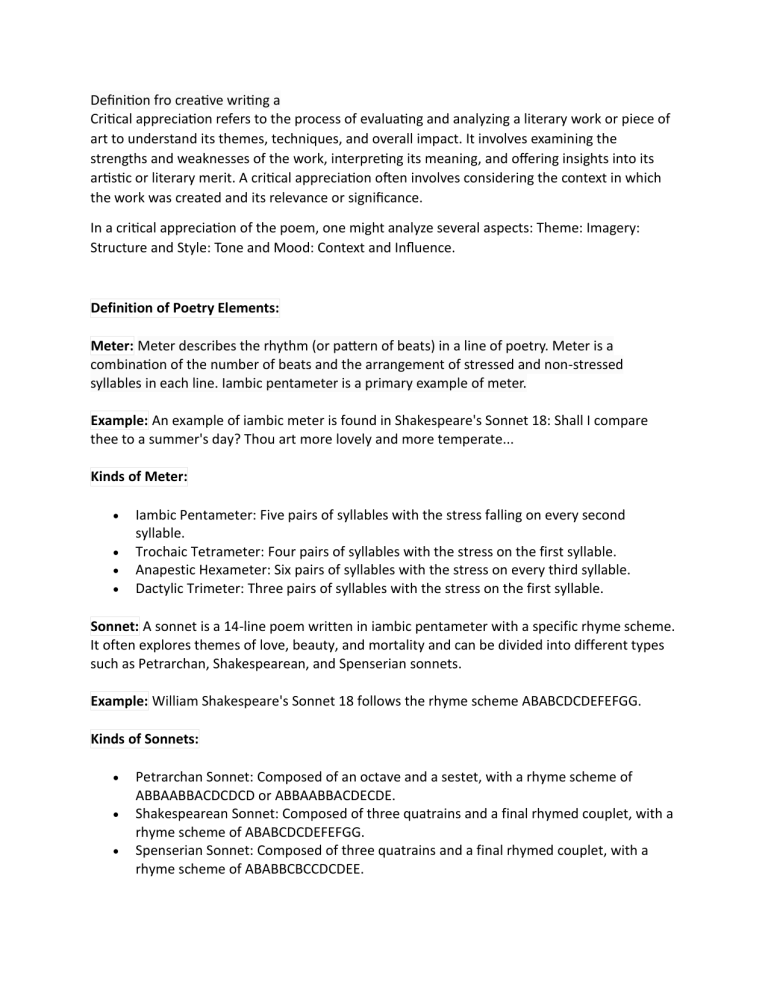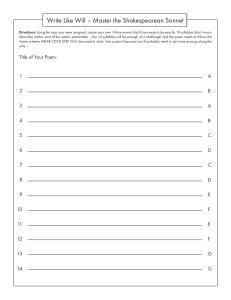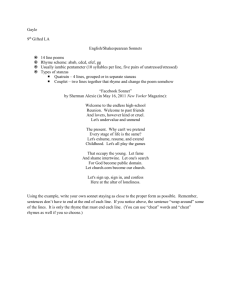
Definition fro creative writing a Critical appreciation refers to the process of evaluating and analyzing a literary work or piece of art to understand its themes, techniques, and overall impact. It involves examining the strengths and weaknesses of the work, interpreting its meaning, and offering insights into its artistic or literary merit. A critical appreciation often involves considering the context in which the work was created and its relevance or significance. In a critical appreciation of the poem, one might analyze several aspects: Theme: Imagery: Structure and Style: Tone and Mood: Context and Influence. Definition of Poetry Elements: Meter: Meter describes the rhythm (or pattern of beats) in a line of poetry. Meter is a combination of the number of beats and the arrangement of stressed and non-stressed syllables in each line. Iambic pentameter is a primary example of meter. Example: An example of iambic meter is found in Shakespeare's Sonnet 18: Shall I compare thee to a summer's day? Thou art more lovely and more temperate... Kinds of Meter: Iambic Pentameter: Five pairs of syllables with the stress falling on every second syllable. Trochaic Tetrameter: Four pairs of syllables with the stress on the first syllable. Anapestic Hexameter: Six pairs of syllables with the stress on every third syllable. Dactylic Trimeter: Three pairs of syllables with the stress on the first syllable. Sonnet: A sonnet is a 14-line poem written in iambic pentameter with a specific rhyme scheme. It often explores themes of love, beauty, and mortality and can be divided into different types such as Petrarchan, Shakespearean, and Spenserian sonnets. Example: William Shakespeare's Sonnet 18 follows the rhyme scheme ABABCDCDEFEFGG. Kinds of Sonnets: Petrarchan Sonnet: Composed of an octave and a sestet, with a rhyme scheme of ABBAABBACDCDCD or ABBAABBACDECDE. Shakespearean Sonnet: Composed of three quatrains and a final rhymed couplet, with a rhyme scheme of ABABCDCDEFEFGG. Spenserian Sonnet: Composed of three quatrains and a final rhymed couplet, with a rhyme scheme of ABABBCBCCDCDEE. Ballad: A ballad is a narrative poem that tells a story, often with a musical quality and emotional appeal. It typically follows a simple and repetitive structure, making it easy to remember and recite. Example: Samuel Taylor Coleridge's "The Rime of the Ancient Mariner" is a famous ballad that tells the story of a sailor's supernatural experiences at sea. Limerick: A limerick is a humorous five-line poem with a strict rhyme scheme (AABBA) and a specific meter. It often features witty or playful content and is known for its light-hearted tone. Example: Edward Lear's limerick: There was an Old Man with a beard, Who said, 'It is just as I feared! Two Owls and a Hen, Four Larks and a Wren, Have all built their nests in my beard!' Free/Blank Verse: Free verse or blank verse is poetry that does not follow a strict meter or rhyme scheme. It allows poets greater freedom in expressing their ideas and emotions, relying on natural speech rhythms. Example: Walt Whitman's "Leaves of Grass" is a renowned collection of free verse poetry that celebrates democracy, individualism, and the beauty of the American landscape. Rhyme: Rhyme refers to the repetition of similar sounds at the end of lines in a poem. It adds musicality and can create a sense of cohesion or playfulness. Types of rhyme include end rhyme, internal rhyme, and slant rhyme. Example: In the poem "Stopping by Woods on a Snowy Evening" by Robert Frost, the repeated rhyme scheme (AABA BBCB CCDC DD) contributes to its lyrical quality and reflective mood. Haiku: A haiku is a traditional Japanese form of poetry consisting of three lines with a syllable pattern of 5-7-5. Haiku often focuses on capturing a moment or feeling, particularly related to nature, with simplicity and depth. Example: Matsuo Basho's haiku: An old silent pond... A frog jumps into the pond— Splash! Silence again. Enjambment: Enjambment occurs when a sentence or phrase in poetry continues onto the next line without a pause or punctuation. It can create a sense of flow, suspense, or surprise, enhancing the poem's rhythm and meaning. Example: In Shakespeare's Sonnet 116, enjambment is used to maintain the flow of thought across lines: Love is not love Which alters when it alteration finds, Or bends with the remover to remove...



